https://www.safehome.org/resources/keeping-house-clean-flu-coronavirus/
Including How to Disinfect Frequently Touched Objects and Deep-Cleans
Written by the SafeHome Team Updated March, 2020
This guide explains why your home is an important front in the battle against germs and viruses, and covers best practices for cleaning everyday objects, keeping the home safe, and what to do before, after and during your family and guests visit.
No matter how organized and health-conscious you are, it can be tricky to virus-proof your home. Here’s why:
- People are too familiar with their homes and easily miss danger spots.
- Homes have many potentially risky surfaces such as kitchen sponges, desks, dishcloths, floors, soap dispensers and toilets.
- Visitors may introduce germs and viruses into the home after you’ve cleaned.
- No one wants to constantly clean.
- You may be caring for a sick person in your home.
- Keeping a home clean requires frequent handwashing. Even adults have a hard time summoning the energy to wash their hands seemingly every 30 minutes.
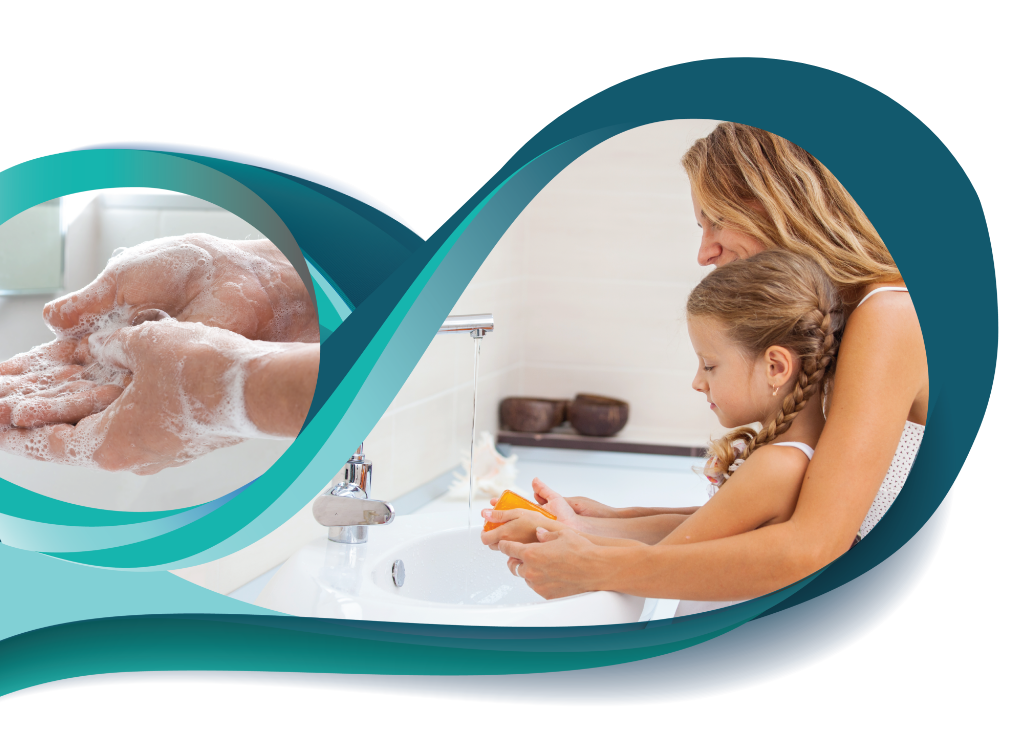
View from the Experts: Protecting Your Home Against Flu, Coronavirus and Other Illnesses
“If you’re sick, it does make sense to steer clear of household members as much as you can, though a strict quarantine is likely not necessary. It should also be emphasized that [just] as important as household quarantine is making sure that you stay home from work or school when you are ill to prevent spread to others.”
– Dr. Stacey Rose, Assistant Professor of Medicine (Infectious Diseases) at Baylor College of Medicine in Houston
“You’ve got a lot more mucus production, coughing, et cetera. It sets you up for possibly a bacterial infection [such as bacterial pneumonia] on top of [flu symptoms].”
– Dr. Peter Shearer, Director of the Emergency Department at the Mount Sinai Hospital in New York City
“Soap and water works really well. It can dry your hands out a little bit more but when you do it, you want to do it right. That means getting your hands wet with warm water, cleaning them, getting all of the surfaces with soap for 20 seconds — that’s a full time through ‘Happy Birthday’ — and then also rinsing them off afterwards.”
– Emily Landon, Medical Director for Infection Control at the University of Chicago Medical Center
“Sanitizer might feel like a modern-day, scientific, and more clinical upgrade to soap. But I’m here to tell you that soap — all sorts of it: liquid, solid, honeysuckle-scented, the versions inexplicably only marketed to men or women — is a badass, and even more routinely effective than hand sanitizer. We should be excited to use it, as much as possible.”
– Brian Resnick, Senior Science Reporter at Vox.com
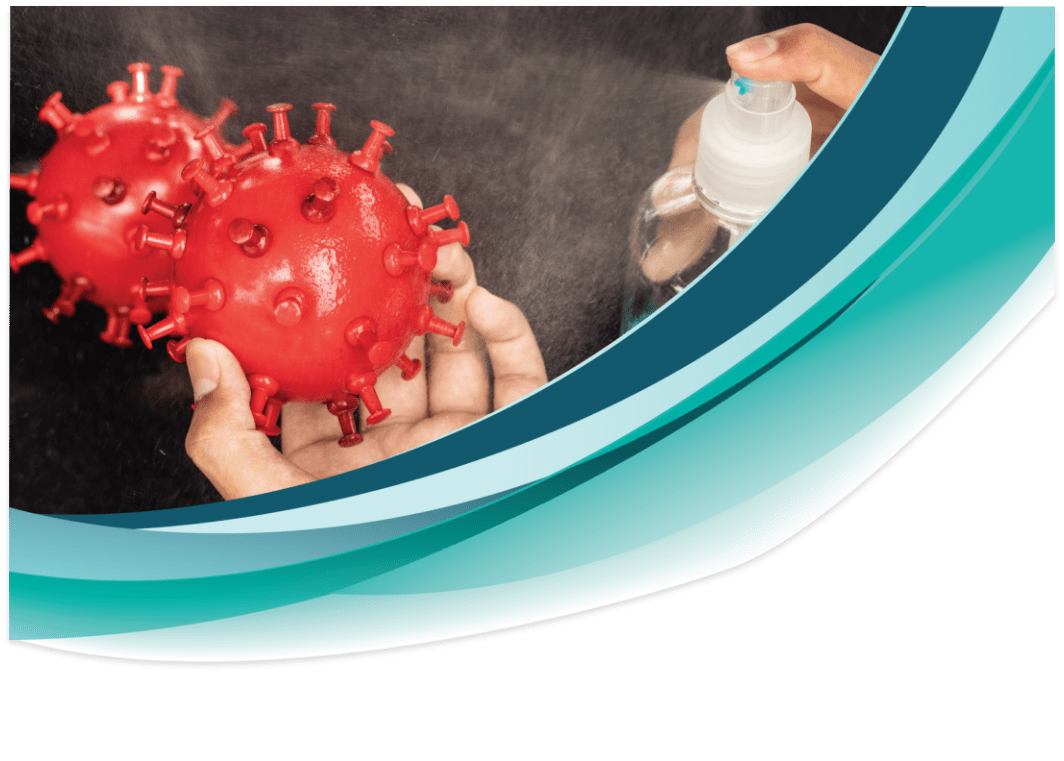
Your Home Is Both a Refuge and a Critical Line of Defense
The Centers for Disease Control and Prevention explains that an epidemic occurs when a community experiences a widespread, often sudden, outbreak of disease.1 Flu epidemics happen nearly every year in many communities. They last several weeks to several months. During these times, you’re at higher risk of getting sick with the flu. Vaccinations do reduce the danger but are not 100% effective. Plus, not everyone can get vaccinated.
The definition of a pandemic is when a disease is prevalent across an entire country or the world. COVID-19 is one such example.2 However, something much smaller than an epidemic or pandemic could throw your household into chaos. For example, noroviruses spread easily through contaminated food, water and surfaces. The American Lung Association points out that even the common cold can be worrisome, especially if someone in the household has a condition such as asthma, chronic bronchitis or emphysema.3 To protect your home, follow these steps:
- Wash your hands frequently and thoroughly for at least 20 seconds.
Experts across the board agree that handwashing is the best way to stay safe. Use paper towels or your elbow to turn the tap off after handwashing. - Stockpile two weeks to a month’s worth of nonperishable food, medications, soap, sanitizer, disinfectants and other supplies.
If you end up not needing these items for an illness, you might for power outages, snowstorms or other situations. - Cough or sneeze into tissues or the inside of your elbow. Cover both your mouth and nose.
Virus droplets can survive in the air for a few hours. On surfaces and objects, they may remain viable for up to three days. - Throw used tissues away in a lined, touchless can or wastebasket.
Handwash right away for 20 seconds (yep, handwashing again!). - Clean and disinfect frequently touched surfaces at least once a day.
Clean first and circle around to disinfecting. Pay attention to cellphones, remote controls, light switches, doorknobs, countertops, desks, keyboards, toilets, toilet handles, sinks and taps, among other things. - Wear disposable gloves to clean and disinfect.
When taking the gloves off, peel them away from your body. Wash your hands after disposing of the gloves (yep, that again!). - Wash your hands when you get home.
Also, take your shoes off before entering the house. Carry non-fabric (vinyl or plastic) purses and backpacks. Disinfect them after arriving home. - Ask guests to wash their hands or use sanitizer.
Hang paper towels in bathrooms instead of cloth hand towels. Keep visits to one room, if possible. Don’t put out communal bowls of food. - Find another place to stay if your apartment building is poorly ventilated or uses recycled air.
Bad ventilation can spread viruses and germs, causing many residents in a building to get sick. - Separate healthy people from sick people.
Sick people in the home should have their own towels, bedding, utensils, e-reader, cellphone and the like. If logistics allow, they should use separate bedrooms and bathrooms. - Perform a deep clean after a sick person recovers.
Among other things, wash bedding, pajamas, clothes and stuffed animals that the formerly sick person used.
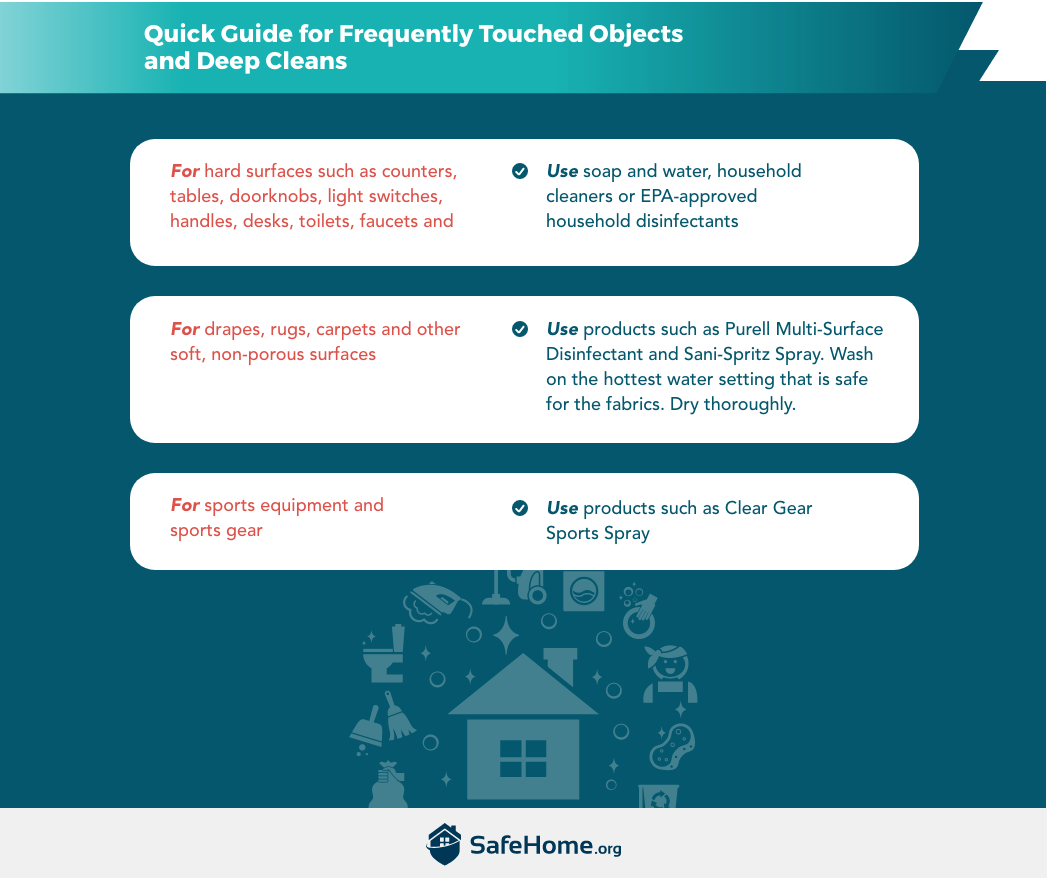 Items such as Clear Gear Sports Spray or household disinfectants might be too expensive or sold out. In these cases, use 70% isopropyl alcohol OR dilute 4 teaspoons of household bleach into a quart of water. Rinse items after you disinfect them so they don’t get discolored or damaged.
Items such as Clear Gear Sports Spray or household disinfectants might be too expensive or sold out. In these cases, use 70% isopropyl alcohol OR dilute 4 teaspoons of household bleach into a quart of water. Rinse items after you disinfect them so they don’t get discolored or damaged.
Why These Measures?
Germs and viruses are not alive per se, but they can remain viable for a decent chunk of time.
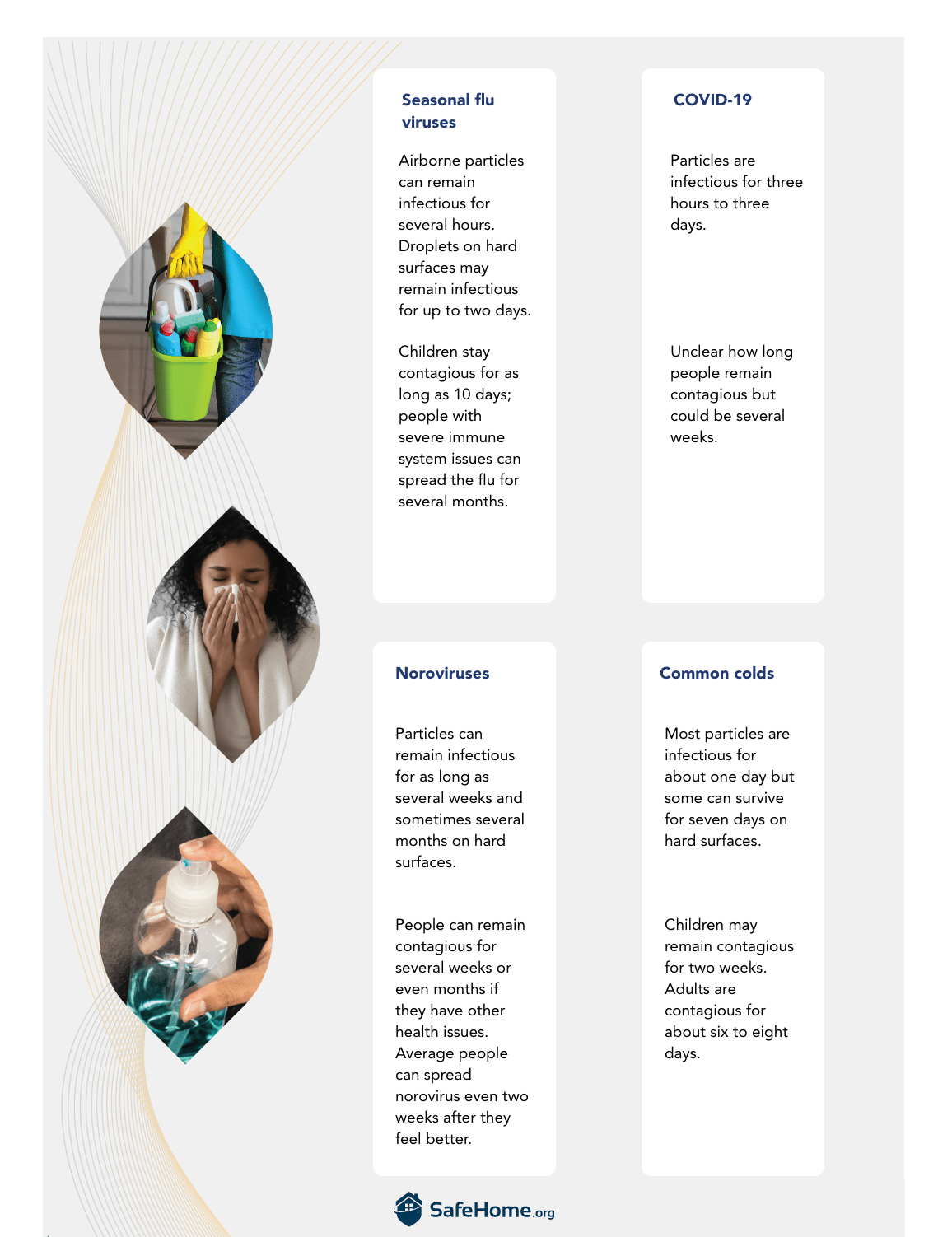 Often, symptoms of these illnesses do not appear right away, or they’re quite mild at first. You could be contagious with no one in the household the wiser. Just one cough, sneeze or conversation could transmit virus droplets throughout the household.
Often, symptoms of these illnesses do not appear right away, or they’re quite mild at first. You could be contagious with no one in the household the wiser. Just one cough, sneeze or conversation could transmit virus droplets throughout the household.
Seasonal flu and COVID-19 can be transmitted to people as far as 6 feet away through droplets from sneezing, coughing or talking. These droplets land in others’ mouths or noses or are inhaled into their lungs. Flu and possibly COVID-19 also spread when people touch an object/surface with the virus on it and then touch their eyes, nose or mouth. However, this method of transmission is less prevalent than airborne transmission.
Noroviruses are a bit different because these viruses spread through stool-contaminated or vomit-contaminated water, food and surfaces (including utensils). Vomiting and diarrhea are major symptoms of noroviruses as opposed to, say, coughing and sore throat.
Apartment Buildings and “Sick Building Syndrome”
Apartment buildings usually have common areas such as lobbies and elevators. Even if workers disinfect these areas often, use sanitizer after you touch door handles, elevator buttons and the like. Wash your hands after entering your apartment. During epidemics and pandemics, building owners and landlords may need to:
- Add more sanitizer stations
- Step up the disinfection of frequently touched objects
- Limit apartment events and gatherings
- Encourage residents to keep 6 feet from one another
- Limit visitor access
- Close gyms, pools or other common areas
- Restrict resident access to the building as a whole
“Sick building” syndrome is real. During crises involving airborne transmission of germs and viruses, you may want to avoid poorly ventilated apartment buildings or buildings that use recycled air, even if they are your own.4 The older your apartment building, the more likely that it uses an outdated and potentially dangerous HVAC system. Ask your landlord when the system was last updated and how safe it is.
Certain Items to Keep on Hand
No matter the time of year, it’s smart to have at least a few days’ worth of toilet paper, tissues, soap and nonperishable food on hand. Of course, you may need more during flu season and virus outbreaks. Aim for two weeks to a month’s worth of these:
- Nonperishable food
- Prescription medications
- Over-the-counter medications, including fever and pain relievers, and cough and cold medications
- Antidiarrheal medications
- Medical supplies such as blood sugar monitoring equipment
- Soap
- Hand sanitizer (at least 60% alcohol)
- Thermometer
- Fluids with electrolytes
- Tissues
- Toilet paper
- Tampons and sanitary pads
- Disposable diapers
- Garbage bags
- Paper towels
- Laundry detergent
- Dish soap
- Household cleaners and disinfectants
- Disposable gloves
- Pet food
Buy these types of nonperishable food items:
- Canned (soup, meats, fruits, vegetables, beans, baby food)
- Frozen (juices, meat, fruits, vegetables, beans)
- Bottled water, coffee, tea, shelf-stable milk, baby formula
- Crackers
- Fruit bars and protein bars
- Dry cereal, granola, oatmeal
- Pasta, bread, rice
- Chicken broth
- Flour, sugar, cooking oil
- Pet food
Look into mail-order medications and grocery delivery, if you haven’t already. They come in handy when you can’t leave home.

Handwashing at Home
Washing your hands is the best way to prevent the spread of many illnesses. It’s also notoriously difficult but doesn’t have to be. (Sanitizer is a weaker option. Use it only if you don’t have access to soap and water.)
When to Wash Your Hands
- Before, during and after food prep
- Before eating
- Before inserting or removing contact lenses
- Before and after caring for someone sick
- Before and after treating a cut or wound
- After getting home
- After touching someone who has a cold or other illness
- After using the toilet
- After changing diapers or cleaning up a child who has used the toilet
- After blowing your nose, coughing or sneezing
- After touching an animal, animal feed or animal waste
- After handling pet food or pet treats
- After touching garbage
Types of Soap to Use
If possible, use bar, liquid or gel soap rather than foam soap.5 Foam washes off more quickly and may not last the 20-second minimum for a handwash.
Bar soaps sometimes look slimy or gross, and bacteria does stay on wet soap. However, the bacteria do not seem to attach to the next user. To ease your mind, rinse soap bars off before lathering your hands. After handwashing, store bars in a good place to dry off.
Don’t stress over using antibacterial soaps.6 Their benefits are unproven. Regular soap works just fine.
How to Wash Your Hands
- Get your hands wet with clean, running water (warm or cold).
- Apply soap and lather generously.
- Scrub all surfaces for at least 20 seconds. Include wrists, backs of hands, between fingers and under fingernails.
- Use a timer or sing songs such as Happy Birthday (twice).
- Rinse your hands under running water.
- Air dry hands or use a clean towel (cloth or paper).
- Turn the water tap off with the towel (or your elbow).
- Keep your fingernails short. Chipped polish, longer nails or artificial nails mean more bacteria.
If you wear rings, it’s fine to keep them on when handwashing. However, the skin around your rings can get irritated with frequent handwashing. So, if you take your rings off, disinfect them before washing your hands. Otherwise, you put potentially contaminated jewelry back onto your hands.
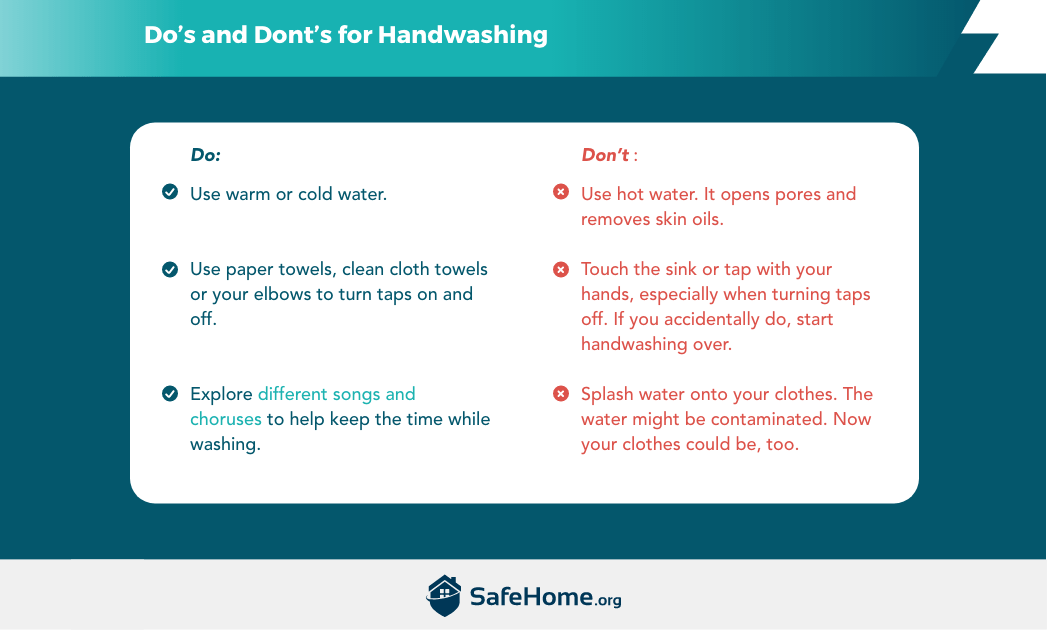 Children and Handwashing
Children and Handwashing
Children need time to develop handwashing skills (heck, many adults do, too). No need to scare the little ones, though. Say something such as, “To protect against nasty bugs, everyone needs to wash their hands so we don’t get sick.”
- Tell/remind your children to wash their hands. Don’t rely on them to remember. Emphasize handwashing after they use the bathroom, play outside, touch pets, and cough, sneeze or blow their nose. Also emphasize it before they eat.
- Make up handwashing songs and games.
- Sing classics such as Mary Had a Little Lamb and Row, Row, Row Your Boat.
- Place a timer in the bathroom.
- Place bright, friendly reminders in bathrooms and near kitchen sinks.
- Put handwashing tutorial charts in bathrooms and near sinks.
- Wash your own hands frequently to lead by example.
Avoid baby wipes as a handwashing substitute. They don’t remove germs and viruses. Sanitizer is OK if no soap and water are available.
Hand Sanitizer
Hand sanitizer is acceptable when soap and water aren’t available. Your sanitizer should be at least 60% alcohol (look at the front or back product label). Keep sanitizers out of reach of children and pets.
- Read the product label for the appropriate amount of sanitizer to use.
- Apply sanitizer to the palm of one hand.
- Rub hands together for 20 seconds until hands and fingers are dry.
- Be sure to get sanitizer on all surfaces of hands and fingers.
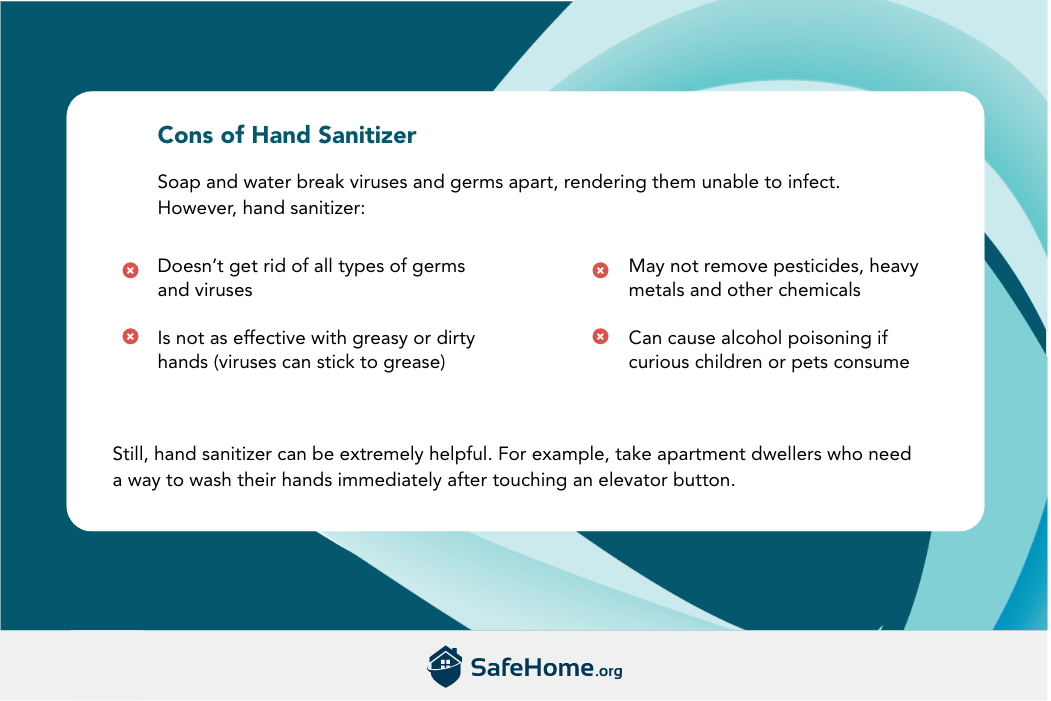
Coughing and Sneezing in the Home
Cover your mouth and nose when coughing or sneezing, even when you’re home. It protects other residents because fewer droplets land in their respiratory system and on various surfaces.
- Carry tissues to use as the default.
- Turn to the inside of your elbow when coughs or sneezes take you by surprise.
- Cover both your mouth and nose.
- Dispose of tissues in a lined trash can (use touchless, foot-operated or motion-sensor trash cans, if possible).
- Wash your hands immediately for at least 20 seconds.
- Opt for a hand sanitizer with at least 60% alcohol if soap and water are not available.
Frequently Touched Objects and Surfaces
Remember these objects and surfaces when performing your daily clean and disinfect. If possible, do disinfecting more than once a day:
- Cellphones
- Remote controls
- Keyboards and mice
- Eyeglass arms
- Children’s favorite toys
- Countertops
- Kitchen sponges
- Dishcloths
- Desks
- Floors
- Sinks and taps
- Toilets and toilet handles
- Light switches
- Doorknobs and door handles
Most of these objects can be disinfected with EPA-registered disinfectants.7 Two common brands are Clorox and Lysol. Check a product’s label to be sure it works for whatever virus or illness you’re targeting.
For cellphones, tablets and other mobile devices, Apple recommends a, “70 percent isopropyl alcohol wipe or Clorox Disinfecting Wipes.”8 Otherwise, you can use a 60% water and 40% rubbing alcohol solution. Lightly wet a cotton swab or the corner of a microfiber cloth with the solution, and wipe your device down.
To disinfect keyboards, unplug them or turn them off. If the keyboard is part of a laptop, turn the laptop off and disconnect the charging cord. If possible, remove the battery. Hold the keyboard upside down and shake it to prod some debris loose. Blow compressed air around the keyboard or try clear tape. Next, grab a disinfectant wipe. Squeeze it above the sink or trashcan in case it has too much liquid. Gently use the wipe to disinfect keys and the palm rest. Don’t use wipes that have bleach (they can damage the keyboard surface).
Turn off or unplug your computer mouse and remove any batteries. Use disinfectant wipes, squeezing them first to get rid of any excess moisture. For a touchpad mouse on a laptop, turn the laptop off and use the wipe to disinfect the pad. Let your keyboard and mouse dry for at least a minute before you use them again.
Now onto something decidedly lower-tech: Throw kitchen sponges out after one-time use. Zapping them in the microwave isn’t enough. Weaker germs or viruses may die, but stronger ones survive. However, if you cannot throw sponges out after every use, that’s understandable. Wet them and heat them in the microwave for two minutes. Throw them out every two weeks.
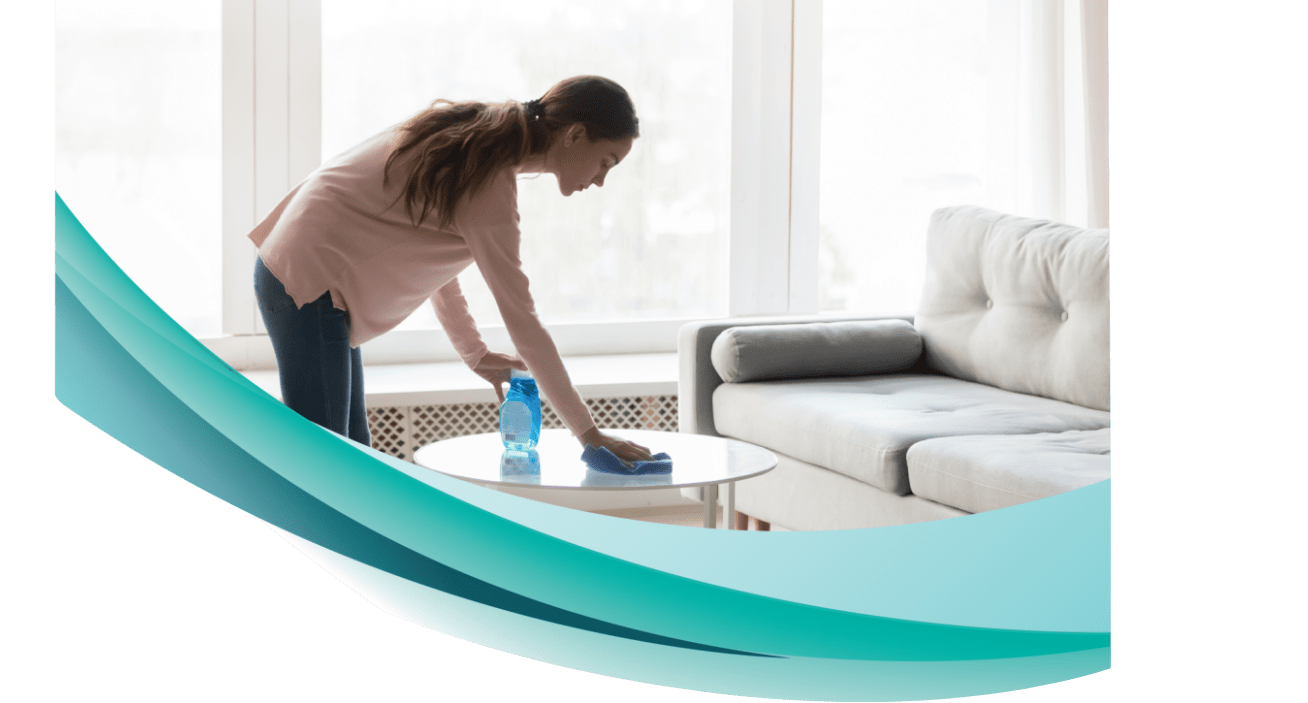 Options for Disinfectant
Options for Disinfectant
- EPA-approved household disinfectants: Follow manufacturer directions as to concentration, application method and contact time.
- Homemade disinfectant (bleach solution): Mix 5 tablespoons of bleach (1/3 of a cup) per gallon of water, or mix 4 teaspoons of bleach per quart of water.
- Alcohol disinfectants: Use solutions containing at least 70% alcohol.
- Check that the bleach is unexpired. Expired bleach is less effective.
- Don’t mix bleach with ammonia or other cleansers.
- Wear disposable gloves while disinfecting.
- Wash hands thoroughly after throwing away gloves.
Sick People at Home
It’s common for one or two people in a household to come down with an illness. Rather than resign yourself to becoming sick too, follow a few steps.
Isolate
- Separate sick and healthy residents.9 If possible, both sets should have their own bedrooms and bathrooms. They should definitely not share pets, hand towels, bath towels, bedding, books, utensils, plates or anything. Both sets should store their toothbrushes out of shared bathrooms.
- Use paper towels instead of cloth towels in kitchens and bathrooms.
- Assign just one person to care for the sick person (or sick people).
- Stay at least 6 feet from sick people.
Protect
- Wear masks and disposable gloves when caregiving. Have the sick person wear masks as well (unless the masks cause breathing problems or other issues).
- Wash your hands frequently, especially after touching a sick person’s devices, laundry and dishes.
- Avoid touching your face.
- Disinfect frequently touched surfaces at least once a day. If sharing bathrooms and bedrooms, put extra emphasis on light switches, doorknobs, toilet lids, seats and handles, and the floor near the toilet (particularly for stomach viruses/noroviruses).
You don’t have to do dishes or laundry for a sick person separately. However, don’t hold the person’s clothes close to your body. Wash your hands right away after touching dirty laundry.
After Recovery
How do you know when it’s OK to welcome a sick person back into the swing of life in the household? It depends on the specific illness. In general, wait until the person has been fever-free and symptom-free without the assistance of drugs for 24 hours. For illnesses such as COVID-19, it’s not clear yet how long to wait. For noroviruses, remember that people can remain contagious even two weeks after they’ve recovered.
- Practice diligent handwashing.
- Clean and disinfect commonly touched bedroom surfaces such as door handles, light switches and nightstands. Wear disposable gloves.
- Run the formerly sick person’s plates and utensils through the dishwasher before adding them back to the household supply.
- Wash bathroom rugs, towels and hand towels at the highest water temperature possible. Dry them on high heat.
- Clean and disinfect light switches, doorknobs, toilet lids, seats and handles, and the floor near the toilet (particularly for stomach viruses).
- Throw out toothbrushes and disinfect holders.
- Wash bedding, pajamas, clothes and stuffed animals that the formerly sick person used or came close to.
- Disinfect books, bedside table items, TV remote controls and other items that the formerly sick person used.
Guests in the Home
Maybe your neighbors have popped over for a quick visit, or you’re having the entire family over for five days over the winter holidays. Either way, visitors increase the risk of someone becoming sick.
- Use paper towels instead of cloth towels.
- Keep tissues, cough drops and bottles of sanitizer handy.
- Stock up on soap, and post handwashing signs.
- Avoid touching your mouth, nose and eyes.
- Skip shared glasses, communal bowls, popcorn, bags of chips and other shared food.
- Rinse fruit such as bananas, oranges and apples before eating them.
- Perform elbow bumps instead of hugs and handshakes.
- Disinfect common areas and frequently touched areas multiple times a day.
- Open windows and adjust air conditioning as needed.
Not everyone knows proper coughing and sneezing procedures. If necessary, remind your guests to use tissues or the inside of their elbow.
If you’re sick (or think you could be sick), don’t be afraid to cancel a gathering. That’s especially true if the gathering could expose young children, senior citizens or people with chronic health problems to a virus. If you have norovirus, do not prepare food for others when sick and for two days after symptoms go away.
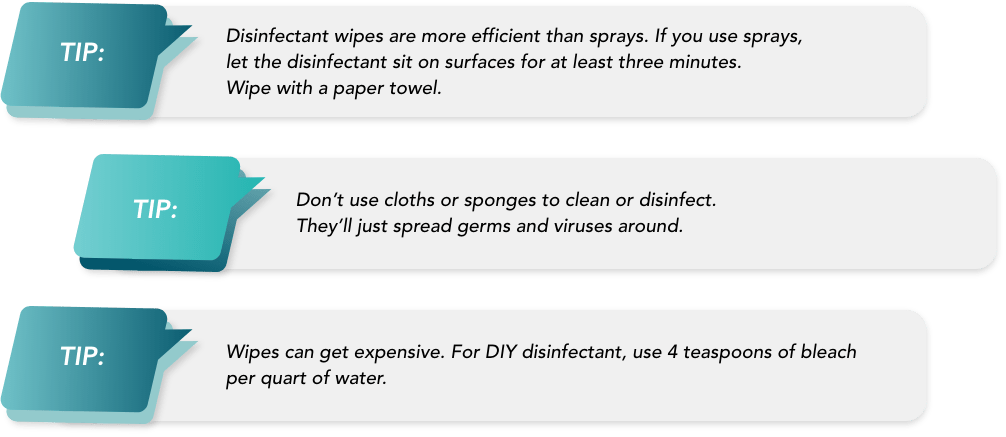
Arriving Home After Being Out
Everyone has been out. You went to work then headed to the gym. Your spouse also worked then went shopping. Meanwhile, your kids attended school and hung out at a friend’s house. Now you all are home—and potentially teeming with germs and viruses. How do you make sure they don’t invade your home?
- Take your shoes off before entering.
- Wash your hands right after arriving home, and handwash often while you’re home.
- Use non-fabric purses and backpacks that are easy to clean. Disinfect them soon after getting home.
- Disinfect frequently touched spots.
- Remember cellphones, tablets and other mobile devices when disinfecting!
- Open windows and adjust air conditioning as needed.
Keeping Your Home Safe During Flu and Virus Seasons
It’s a challenge to keep your home safe in the face of contagious, easily spreadable illnesses. Handwashing, no matter where you are, is the best thing you can do.
It’s also important to disinfect frequently touched surfaces, including cellphones, toilet handles, light switches, soap dispensers and water taps. If someone in your household gets sick, don’t share anything. Give sick people their own bedroom and bathroom, if possible.
Being proactive goes a long way. Stock up on a few weeks’ worth of tissues, paper towels and nonperishable food. Make a plan in case you need medications and food delivered to your home.
Additional Resources
The Flu: Caring for Someone Sick at Home
Healthy Habits to Prevent Flu: Vaccinations and Health Habits
Children and Handwashing: A Family Activity
Coronavirus: How to Easily Clean Everyday Household Objects
Why Soap Annihilates the Coronavirus: A Chemistry Professor Explains
Norovirus Prevention: Hand Hygiene and Food Preparation
Common Colds: The Main Reason People Miss School and Work
References and Footnotes
1. Principles of Epidemiology. (2012, May 18). Retrieved March 16, 2020, from https://www.cdc.gov/csels/dsepd/ss1978/lesson1/section11.html
2. Chappell, B. (2020, March 11). Coronavirus: COVID-19 Is Now Officially A Pandemic, WHO Says. Retrieved March 16, 2020, from https://www.npr.org/sections/goatsandsoda/2020/03/11/814474930/coronavirus-covid-19-is-now-officially-a-pandemic-who-says
3. Facts About the Common Cold. (n.d.). Retrieved March 16, 2020, from https://www.lung.org/lung-health-and-diseases/lung-disease-lookup/influenza/facts-about-the-common-cold.html
4. Fundamentals of Indoor Air Quality in Buildings. (2018, August 1). Retrieved March 16, 2020, from https://www.epa.gov/indoor-air-quality-iaq/fundamentals-indoor-air-quality-buildings
5. The Power of Hand-Washing to Prevent Coronavirus. (2020, March 6). Retrieved March 16, 2020, from https://www.medscape.com/viewarticle/926373
6. Antibacterial Soap? You Can Skip It, Use Plain Soap and Water. Retrieved March 16, 2020, from https://www.fda.gov/consumers/consumer-updates/antibacterial-soap-you-can-skip-it-use-plain-soap-and-water
7. Disinfectants for Use Against SARS-CoV-2. (2020, March 13). Retrieved March 16, 2020, from https://www.epa.gov/pesticide-registration/list-n-disinfectants-use-against-sars-cov-2
8. How to Clean Your Apple products. (2020, March 12). Retrieved March 16, 2020, from https://support.apple.com/en-us/HT204172?mod=article_inline
9. Preventing 2019-nCoV from Spreading to Others. (2020, March 6). Retrieved March 16, 2020, from









